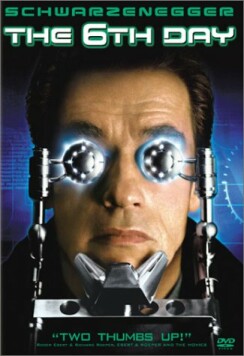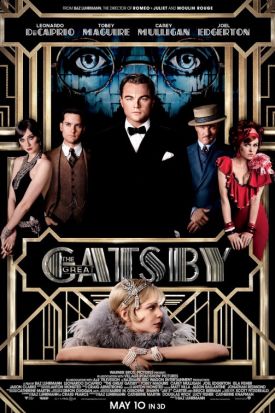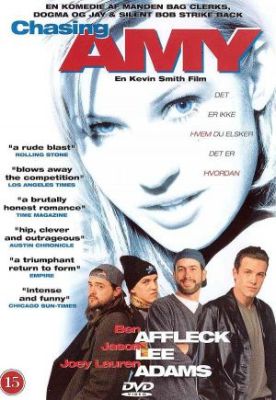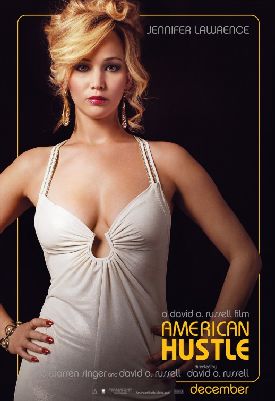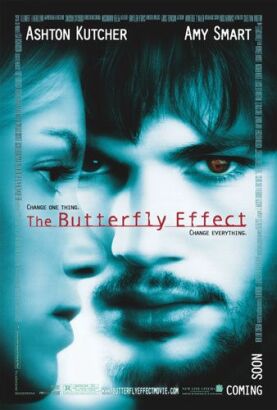Sixth Day, The
The Sixth Day, directed by Roger Spottiswoode, is a movie about
cloning that is itself a clone — a
genetic duplicate of every other Arnold Schwarzenegger vehicle of the last 15 or
20 years. Actually, it is a clone of a clone of a clone, since the
Schwarzenegger movie is itself a clone of a Lucas/Spielberg, Indiana Jones-style
po mo action flick, which in turn is a clone of a real movie — that is, one
which expected us to believe in its hero as something approximating a real
person. Unfortunately, cloning technology back in the 1970s was not what it is
today — still less, as we learn here, what it will be in the future — so the old-fashioned movie came out looking like a cartoon. Nowadays, of course, we have come to expect nothing better from the movies than cartoons, and in the future this will doubtless be even more true. Therefore, we are quite happy to appreciate the cartoonish Arnold for what he is,
which is an antiseptic, genetically-engineered version of the classic movie
hero.
Significantly, cartoons are chiefly notable for their protean sense of
reality. In cartoons, characters are regularly shot or blown up and then
reappear in the next frame as good as new. In the new world of cloning the same
thing happens, only with a plausible superstructure of scientific explanation.
The dead ones have not only their genetic material on file but also their
memories downloaded and regularly updated in a database kept in the gleaming
corporate headquarters belonging to one Michael Drucker (Tony Goldwyn). There,
he keeps also a crop of
“blank”
grown bodies in quasi-fetal poses in vast tanks of some kind of amniotic fluid.
Properly inoculated with the dead
person’s DNA and with the latest
downloading of his memories installed, the blanks are fashioned into human
creatures indistinguishable from the dead person with, apparently, no more
difficulty than the Coyote or Sylvester the Cat or Elmer Fudd regenerate
themselves after similarly lethal accidents.
All this must be done, however, surreptitiously, and in the face of a
nationwide legal ban on human cloning. Ten years before the events of this movie
there had been some kind of disastrous experience with human cloning which led
to the ban. The story concerns the accidental cloning of Adam Gibson (Mr.
Schwarzenegger), whom the Drucker people mistakenly believe has been killed in
the assassination of Drucker himself. When Drucker is instantly re-incarnated,
so is Gibson — only it
wasn’t him but Hank (Michael
Rapaport), his partner in a helicopter rental business, who was killed. As a
result, there are now two Gibsons instead of one, both of them, in spite of
their Scottish name, speaking with thick Austrian accents. One of them (it
doesn’t matter which) must be disposed
of by the Drucker goons, led by Michael Rooker, before the duplicate alerts the
authorities to the illegal cloning operation.
You will be pleased but not surprised to know that both Arnolds are up to the
task of defending themselves and their little
family — wife Natasha (Wendy Crewson)
and daughter Clara — against these
determined assassins. But both are more and more surprised as the bad guys
apparently keep coming back from the dead. Eventually getting the idea, both
Arnolds go after the sinister Drucker himself, in his corporate lair, together
with the conscience-stricken scientist, Griffin Weir (Robert Duvall) who has
developed the cloning technology for him. Weir is preoccupied with the impending
death of his beloved wife — who is
herself a clone of the wife who already died five years before. He learns that
Drucker has secretly given the clone another fatal disease as a form of
planned obsolescence and is understandably
upset — as he is by the
wife’s insistence that she
doesn’t want to be brought back yet
again.
Nothing much is done with this moral problem. As Weir reaches his crisis of
conscience he is simply shot. Here and elsewhere there are occasional gestures
in the direction of a quasi-Frankensteinian
“message”
to the movie, but in the end it is too busy being a Schwarzenegger movie to
bother about that. The little post-modern jokes really are its raison
d’être. That
and the special effects, of course. These are predictably spectacular, though
somewhat disappointingly low-tech for such a futuristic movie. The jokes are
even better, with Arnold carrying off with his stolid Teutonic aplomb a number
of variations on the inevitable theme of
“I
haven’t been myself
lately.” At one point the bad guy,
Drucker, is shouting at his hired goons about their failure to kill either the
Gibson original or the Gibson clone and says:
“There are four of you and one of
him — well, two of him, if you see what I
mean.” I also like the bit where
Gibson gets through Drucker’s
HQ’s security system by carrying with
him the manicured thumb of the female goon, shot off in a ray-gun fight, for use
wherever the electronic guardians instruct him to
“insert
thumb.”
There are also some gentle satirical shafts intermingled with the other
jokes — smoking having been made
illegal, for example, Gibson and his wife enjoy the guilty pleasure of a shared
stogie (of the kind which, everyone knows, Arnold smokes in real-life) out in
the garage one night. The other Arnold pretends to be as upset about his
doppelgänger’s smoking his
cigars as sleeping with his wife. Later, when swooped on by those she thinks the
police, Natalie says: “This
isn’t about the cigars is
it?” Subsequently captured along with
their daughter, she is rescued by one of the Arnolds (who knows or cares
which?), who says to one of the goons who has been guarding them:
“Don’t move: my daughter is just
inside that door, and I don’t want to expose her to any graphic violence. She
gets enough of that from the media.”
If this kind of thing seems like a laff riot to you, you may enjoy this
movie.
Discover more from James Bowman
Subscribe to get the latest posts to your email.

